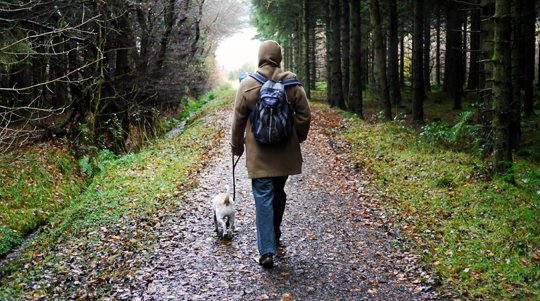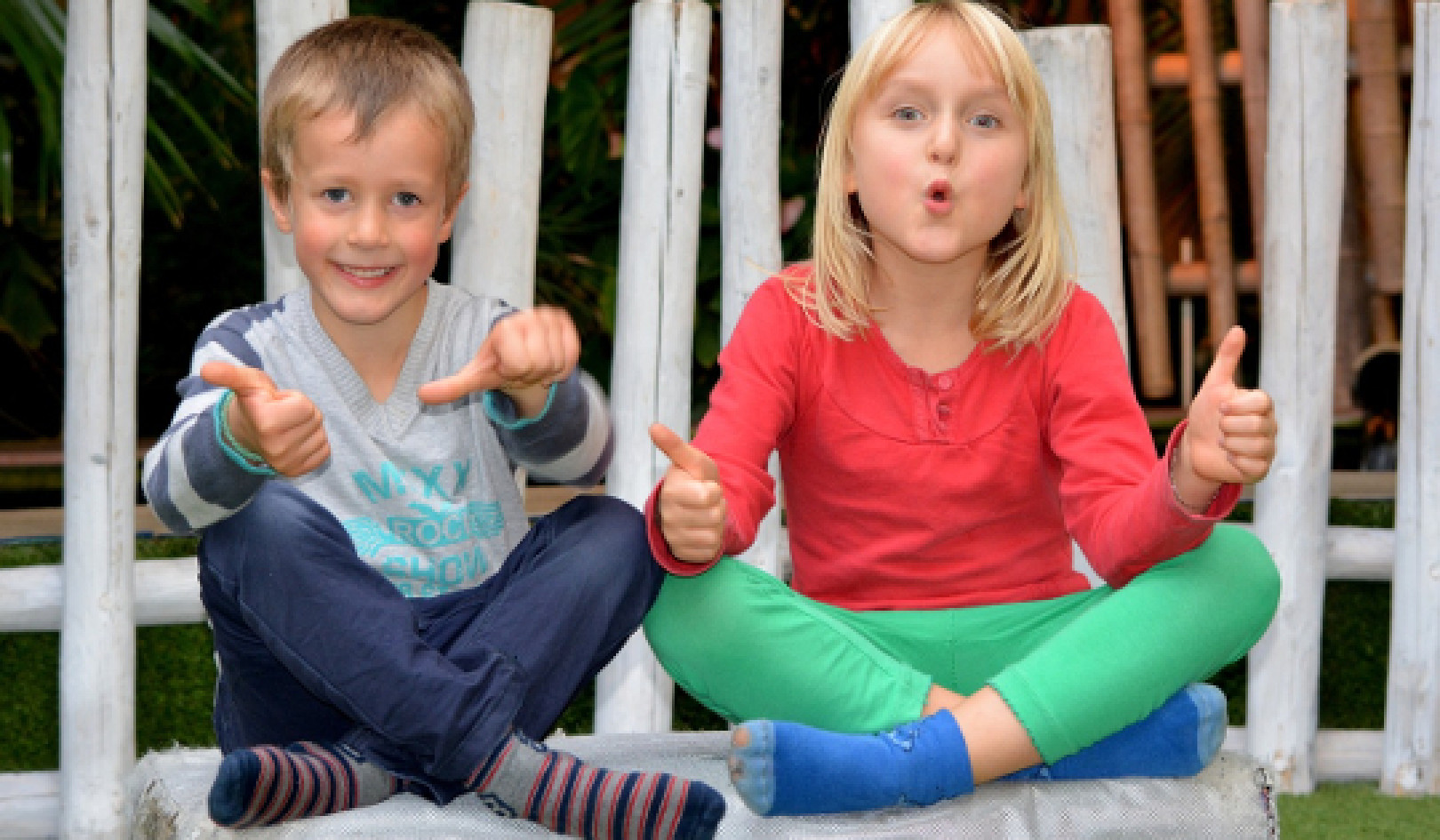
It all started with a postcard. A postcard with a picture of earth taken from space. Against a shiny black sky, our planet glowed with swirly blues and purples, framed by two lines of a message: “Wake up! You live here!”
The message itself punched me smack in the chest and set off an alarm inside. I had just been outdoors, but I couldn’t say what the sky looked like, cloudy or clear, or whether birds sang or if I’d felt a breeze on my cheeks. I had been locked inside my head, thinking. I didn’t live with awareness inside my own body, much less on the earth.
After that, a phrase I’d heard all of my life, “Come to your senses,” began to take on new meaning. I abruptly awakened to my senses, to dramatic consequence.
I liked this heightened awareness, and I wanted to be even more conscious of life around me. That morning, I was tapped on the shoulder by life itself, and I was finally ready to answer the call.
Sleepwalking or Wake-Walking?
I began to spend more time outdoors, taking my black-and-white shaggy pup, Tess, for leisurely three- and four-mile hikes along Flat Creek. Yet, often, I was still sleepwalking, unaware of my surroundings and deep in my thoughts. I could miss the most wonderful things along the path: sunlight through golden aspen leaves, the sound of creek water clattering the rocks. I would come home exercised, but not enlivened.
I wanted to be wake-walking.
I began to break down how perception moved through consciousness. I wanted to learn how to cooperate with my natural system to get fully awake on my planet.
When I figured it out, I categorized the information into a three-step process that correlated to the work of the three parts of the brain: reptile, midbrain, and neocortex. I called my outings Spirit Walks, to remind me to be aware of the spirit of my experience.
A New World of Awareness
Throughout this research, layers and layers of understanding unfolded, and once I began to use that knowledge, a whole new world of awareness opened to me. Many unexpected gifts surfaced.
The three-step process discussed here was inspired by a book I was reading at the time, called The Intuitive Way. In it, author Penney Peirce describes how information travels through our bodies and minds, alerting our conscious awareness.
In general, the first level of awareness in our bodies arises from instinct — desire, pain, pleasure. Our senses trigger awareness of these primitive urges the way touching a baby’s cheek induces the baby to make sucking motions or the way saliva is released before we know consciously that we smell apple pie.
The information then moves into the conscious awareness of our senses: we know we smell apple pie and begin to look for the aroma’s source. Next emotion arises in response to what our senses bring us — perhaps we experience a fleeting desire to be cared for or comforted. Then we create meanings and associations between sensory information and our inner life: hopes, memories, fears, and dreams. We remember Grandma and her apple pie; we wonder whether we’ll ever taste one again.
Finally, the data moves into the language area of the brain, where we can label and sort it into abstract ideas and definite plans. If we call Grandma and tell her we’ve been dreaming about her apple pie, maybe she’ll give us the recipe.
Three-Part Formula for a Spirit Walk
This mental pathway corresponds with the three-part formula for a Spirit Walk: naming, which serves to alert our conscious awareness to the senses; describing, which engages our senses and body responses on a deeper, more intimate level; and interacting, which invites us to create a relationship with our surroundings.
Our five senses are our doorways into a fuller experience of our bodies, our writing, and our planet. When I consciously take in the fragrance of pine, the acknowledgment attaches my feet to the ground I stand on, the space I share with the pine tree. I reside more fully in my muscles, my bones, and I become aware of how the emotions aroused by my senses act on my organs and their systems. And then I want to tell someone about it.
Pen and paper are the only tools needed for a Spirit Walk. When we write, we pull the whole of ourselves — body, mind, and soul — into engaging with the unconscious and bringing ourselves into full awareness.
Here’s how a recent Spirit Walk worked for me:
With a notebook and pen, I headed out to hike on the top of Snow King Mountain on a blue-sky morning in early June, just before the crowds of summer tourists arrive here in Jackson Hole. This decision meant a ride on the chairlift, which in the past I’d used only during ski season. I’ve always enjoyed the ride then because you can see a hundred miles away into Yellowstone and feel eye to eye with the peaks of the Grand Tetons.
But on this morning, the ride up the mountain frightened me. I was puzzled; the lift had never bothered me before. Now my chest felt constricted; I longed to pull in a deep, satisfying breath but couldn’t.
My toes ached from gripping the insoles of my hiking boots, and my hands were sweaty on the safety bar. In the winter, the resort removed these safety bars so skiers could slip on and off the chairs quickly, so why was I scared with one today? Shouldn’t I feel more secure with it locked in place before me? It helped if I didn’t move, not even my eyes. So much for the beautiful view I was looking forward to seeing. I stared straight ahead, tried not to blink, and hung on tightly.
“Wake up! You live here!”
Once I reached the summit of Snow King, I stepped gratefully off the chairlift onto solid ground and took a deep breath. Remembering the postcard that served as a tap on the neurons — “Wake up! You live here!” — I started to name things I saw. Large things came to my attention first: mountain peaks, clouds, boulders. I wrote them down in my notebook.
Then I used my other senses and began to notice smaller things: the cry of a redtail hawk, the powdery feel of aspen bark, the fragrance of damp earth. Awareness followed a certain order as the senses descended into my less conscious areas, from sight to sound, touch, taste, and smell.
The point was to make a quick list, so I moved on.
As I walked, I kept my senses attuned to my surroundings and gathered more information. Tearing off a leaf of sagebrush, I crushed it in my palm and inhaled the fresh, herby scent; I chewed a leaf and quickly spit it out. Not the same sage we stuff into a turkey.
Across a narrow ridge, with the Tetons flaring snowy peaks on one side and the Gros Ventre Mountains rolling into eternity on the other, I walked up a rocky outcropping and found a place to sit beneath a twisted pine. Out with the notebook and pen again for the second part of my Spirit Walk: describing, or detailing.
I looked for something that especially attracted me and chose a pinecone. As if I were making an intricate drawing, I used language to describe the feel of the pinecone against my cheek, rippled a thumbnail down its scales near my ear — this could be a new musical instrument — and touched my tongue to its dry woodiness.
I had offered this pinecone my full attention. We had a relationship.
I rose and hiked deeper into the forest, listening to the silence, which filled with its own details as soon as I named them: insect buzz, wind rustling my hair, pine needles crunching underfoot, my own breath. I walked around a tall, leafless bush and was abruptly arrested by the way its fuzzy catkins, backlit by the sun, glistened silver against the blue sky. I felt the surprise and joy of Christmas morning.
I recalled plugging in the Christmas tree my husband and I decorated when first married. We were so poor that we formed chicken wire into a cone around a pole and stuff it with green florist paper. No ornaments, only lights.
With this memory, I slipped into the third part of my Spirit Walk. I had opened myself to place and allowed an exchange, or interaction, between the outer world of nature and my inner world of emotion and intimate experience.
Memory Hits The Light of Consciousness
I hiked deeper into the woods and looked for a place where I could write about the catkins glowing like Christmas bulbs. Up ahead, a lodgepole pine had grown with a crook in its trunk. The crook it created made a perfect seat for me. I hoisted myself up and got comfortable as if I were sitting in the tree’s lap. I began to swing my legs.
Like a smoothly spliced movie tape, the image of a Ferris wheel surfaced. My father and I sat together at the top of the Ferris wheel as it stopped to load new riders, and he began to swing his legs. I was young, about nine years old, and this scared me. My father laughed and teased me by pumping harder.
The seat swayed, and I clenched the safety bar, rigid with alarm. I imagined the seat looping right over the top from my father’s movements and me falling out, screaming past all the lights strung on the big wheel. Either my father didn’t believe my fear was real, or he believed he could tease me past it. But my fear was real, and I never moved past it. I never went on a Ferris wheel again, with or without my father.
I was writing all this down, my notebook resting on my knees, my shoulder leaning against the rough bark of the lap tree.
Suddenly, I got it. The chairlift. The reason it scared me today during the summer, when it never had during the winter. The memory hit the light of consciousness, and I felt the beginnings of release from my fear. Now that I understood it, I knew I could stir up the courage to climb back on the chairlift for my return trip down the mountain.
At this point, I had been outside only an hour, but my experience had been one of fullness both inwardly and outwardly. I had become aware of a fear that had been hidden from my consciousness for decades, and I also carried a deeper relationship with this mountaintop, its pinecones and new spring growth, its bird cries and sage aromas.
I had looked closely at the dirt beneath my feet and learned it consisted of insect parts, pine needles, stone chips, wildflower seeds. It was made up of pieces of its surroundings, just as I was made up of pieces of my surroundings.
My Spirit Walk was complete.
©2014 by Tina Welling. All Rights Reserved.
Reprinted with permission of New World Library, Novato, CA.
www.newworldlibrary.com or 800-972-6657 ext. 52.
Article Source:
Writing Wild: Forming a Creative Partnership with Nature
by Tina Welling.
 “Everything we know about creating,” writes Tina Welling, “we know intuitively from the natural world.” In Writing Wild, Tina details a three-step “Spirit Walk” process for inviting nature to enliven and inspire our creativity.
“Everything we know about creating,” writes Tina Welling, “we know intuitively from the natural world.” In Writing Wild, Tina details a three-step “Spirit Walk” process for inviting nature to enliven and inspire our creativity.
Click here for more info and/or to order this book on Amazon.
About the Author
 Tina Welling is the author of Cowboys Never Cry and two other novels. Her nonfiction has appeared in Shambhala Sun, Body & Soul, and a variety of anthologies. She has been a member of the Jackson Hole Writers Conference faculty for fifteen years, and has been conducting her Writing Wild workshops for ten years. She also leads and facilitates the Writers in the Park workshop at Grand Teton National Park. Her website is www.tinawelling.com.
Tina Welling is the author of Cowboys Never Cry and two other novels. Her nonfiction has appeared in Shambhala Sun, Body & Soul, and a variety of anthologies. She has been a member of the Jackson Hole Writers Conference faculty for fifteen years, and has been conducting her Writing Wild workshops for ten years. She also leads and facilitates the Writers in the Park workshop at Grand Teton National Park. Her website is www.tinawelling.com.
























